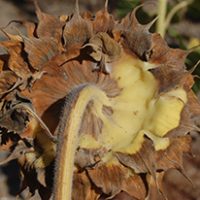A high-performance, natural solution for sunflower crop improvement
BVT’s comprehensive, stackable system uses commercially-reared bees to deliver highly targeted pest and disease control without harmful chemicals.
Increase crop yield
Experience 30% or more yield in sunflower seeds per acre
Higher germination
Get higher sunflower oil content with an improved germination rate
Grow healthier plants
Plants achieve a higher vigor rating than fungicide treated crops
Control disease
Achieve multi year improvements in disease management and reduce soil infestations
Common diseases affecting sunflowers
Sunflowers are susceptible to a number of common diseases that can wreak havoc on plant health, seed yield and ultimately shelf life. The BVT system has been specifically engineered to target these fungal diseases, dramatically improving crops all season long.
What is it?
Sclerotinia head rot is caused by Sclerotinia sclerotiorum which not only causes head rot but also causes stalk rot and wilt. Symptoms of the head rot phase first appear as water-soaked areas on the back or front of the sunflower seed head. As the disease progresses, the fungus can colonize most of the seed head with white mycelium and brown necrotic areas. Sclerotinia head rot also affects yield, oil content and can cause discoloration of seed.
How does it enter the plant?
Ascospores of the fungus are blown onto the sunflower heads, germinate then directly penetrate the plant tissue.
Where does it come from?
The disease is spread by wind borne ascospores after periods of above-normal rainfall at the time of flowering and head development. Sclerotinia sclerotiorum produces hard, black overwintering structures called sclerotia. When conditions are conducive, the sclerotia germinate and produce apothecia and ascospores on the soil surface. These ascospores are the source of inoculum for the head rot phase of the disease.
Additional Resources
What is it?
Rhizopus head rot is a common and often severe fungal disease of sunflowers primarily in the high plains of the USA. The disease appears first as dark spots on the back of ripening heads. The affected heads turn brown and mushy, and then brittle and hard as they dry out.
How does it enter the plant?
The rhizopus fungus enters sunflower heads through injuries produced by hail, birds, or insects including the sunflower moth. The fungus grows on diseased heads as a fuzzy cotton like mycelium covered in black pinhead like structures that are filled with spores. The spores are released into the air when the brittle pinheads shatter. Seeds in affected heads fail to fill properly so have reduced weights, and many may fall to the ground. The oil of infected plants can often be bitter and of poor quality.
Where does it come from?
The fungus is common in plant remains and soils.
Additional Resources
The natural way to improve yields
BVT’s easy-to-use tray system introduces natural organic compounds to sunflower plants using commercially-reared bees.
As the bees pollinate a crop, they leave behind the foundation for a season-long pest and disease management program that encourages even and progressive growth, resulting in a healthy, high yield harvest.

The BVT dispenser system contains the inoculant crop control as a part of the Vectorpak™ tray with Vectorite™ powder. The mixture allows the bees to effectively pick up the product on their way out of the hive.
A natural process to control Sclerotinia
Over the 11 day bloom period of a sunflower, it is critical to have continuous application in a disease management program to out-compete Sclerotinia and other fungal diseases. With the BVT system, commercially-reared bees carry crop controls to each and every ring of a blooming sunflower during their natural process of pollination.

Eliminate traditional spraying
With a traditional spraying program, sunflowers only get sprayed at intervals during the entire blooming cycle. This creates uneven coverage with some blooming rings on sunflowers getting missed while others will have fungicide application – leaving each plant still vulnerable to disease attacks and decreasing overall seed yield.
Start your demonstration today!
Contact one of our representatives to setup an on-site demonstration of the BVT system to experience the improvement it can have on your crop yield.








